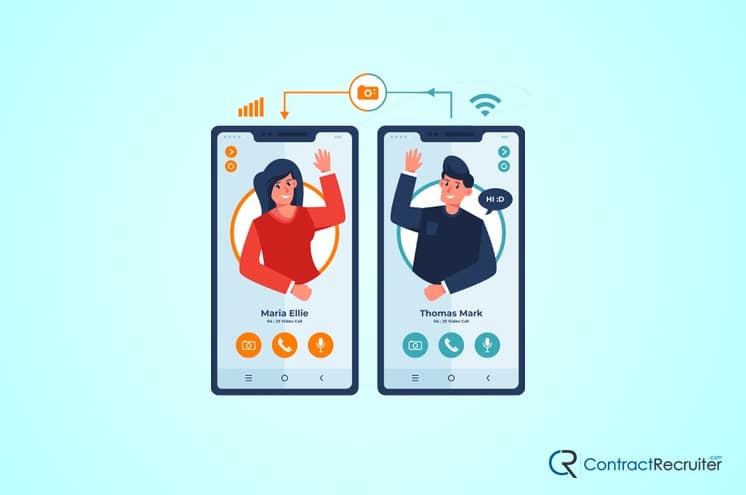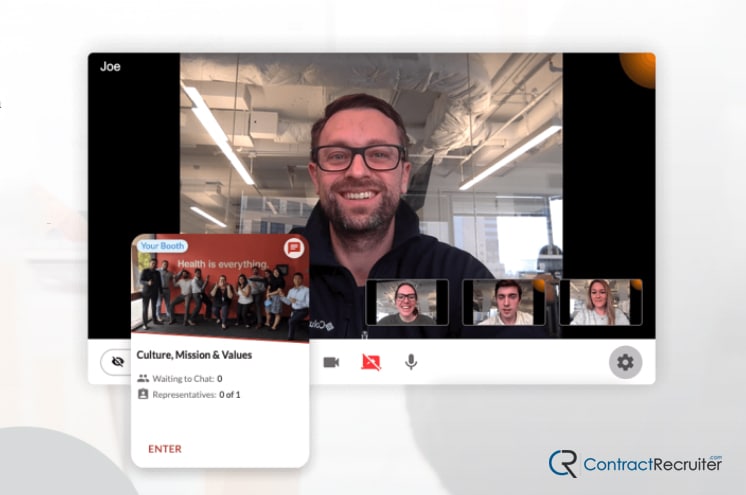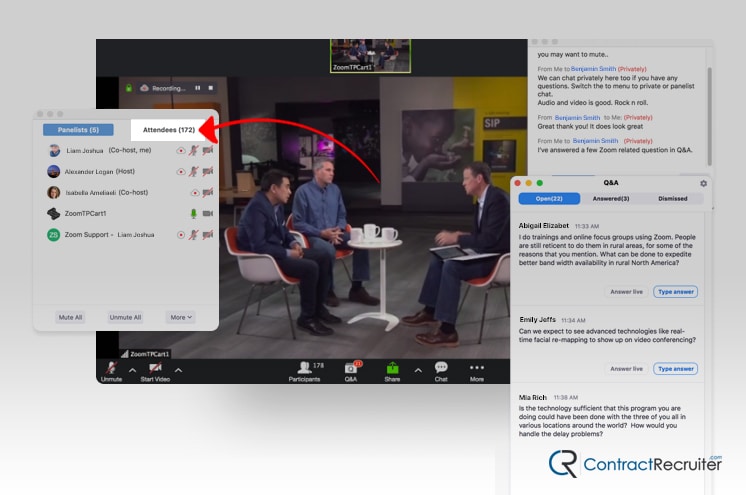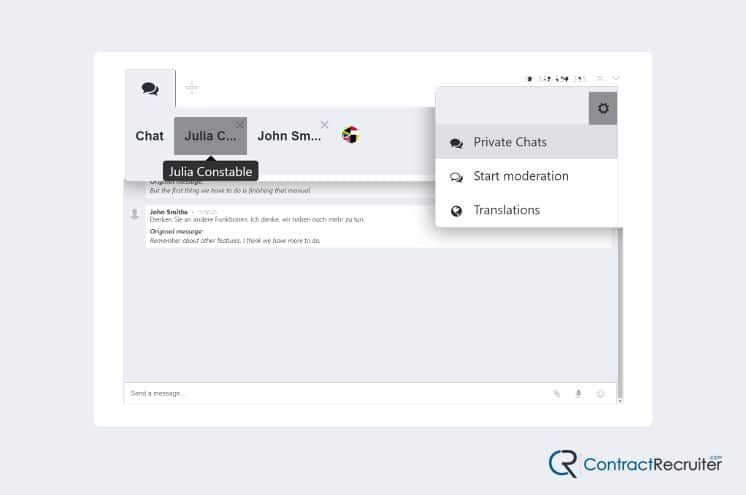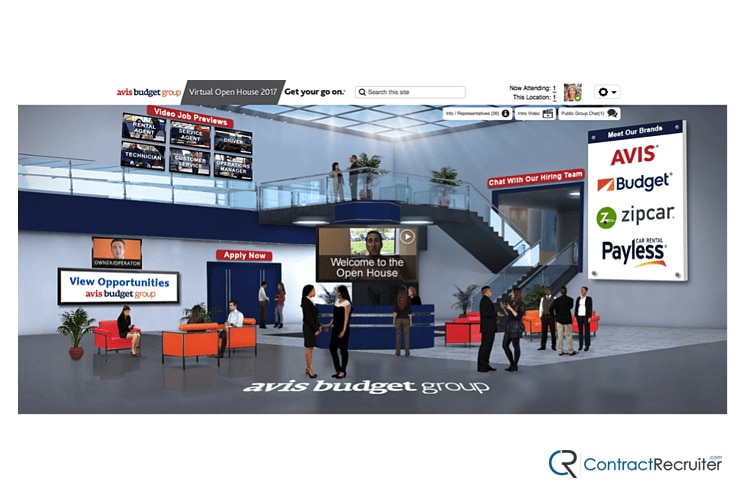You’ve probably heard of major companies like Amazon, IBM, and Disney hosting virtual job fairs, but did you know most companies aren’t using some exclusive software that only works for major multinational corporations? Most business owners that are willing to hire people outside of their immediate area can take advantage of a virtual job fair. The current global conditions have pushed companies to consider remote and virtual alternatives to traditionally in-person activities.
You’re here to research virtual job fairs, potential solutions, and ideas to promote them, so let’s get into it!
What Is a Virtual Job Fair?
If you’ve never experienced a virtual job fair before, it’s easy to fall into the trap of thinking they’re just a fancy name for a careers portal or maybe an event that is centered around recruiting. This impression is close to the mark, but not quite accurate.
When you think of a job fair, what comes to mind? Is it:
- An event hall or exhibition space filled with people?
- Rows of booths and tables, each hosted by a company looking to find qualified candidates?
- Panels and presentations meant to wow, encourage, and entice candidates?
A job fair is similar in many ways to a trade show or convention. In some situations, more than one company may attend to set up their own spaces, with everything from flyers to multimedia presentations, vying for the attention of candidates who attend the fair. They can be regional, or have a focus on a specific industry, or even be comprised of sponsors of the event. They have more in common with a festival than with a careers page.
So what if you were to take this virtual? Imagine an event space with digital booths, 3D renderings of HR team members, and embedded multimedia right on the page. Imagine a virtual event hall with booths that don’t have to worry about size, weight, or space constraints, that isn’t concerned with technology to power embedded multimedia, and that can host information both interactively and attractively.
Moreover, a virtual job fair can combine the best of both worlds. You get your digital event space, but that’s not all; you can mix in live webinars, one on one communication with recruiters, and immediate conversations with candidates. The information they add to their virtual presence can be linked directly to your applicant tracking system, with no need to refer them to another career page or handle paper transcription.
Since it’s all virtual, the event doesn’t have time constraints. You don’t have to worry about an event venue’s schedule, the cost of lodging for your recruiters, or transportation of your booth setup.
The benefits have been touched on, but let’s make it explicit:
- You don’t have to worry about the costs of transportation or lodging.
- In fact, the overall cost of a virtual career fair is much lower than a physical fair.
- You don’t have to worry about setting up technology at the fair.
- You can reach passive and distant candidates who wouldn’t attend an in-person fair.
- You don’t risk the privacy of candidates who wouldn’t want to be seen at a fair.
- You don’t have to worry about the constraints of physical space or physics.
- There’s no attendance cap or capacity maximum for a virtual fair.
- You can still take advantage of direct and in-person conversations with candidates via technology.
Not to mention that, as long as the pandemic is a threat, physical job fairs will be shut down.
A virtual job fair can be an excellent option for just about any business willing to hire outside of their local area, whether it’s for remote work or to pick up a candidate willing to relocate. They’re a great tool for pre-screening and qualifying applicants at the top of the recruitment funnel and for engaging more interested candidates in deeper networking and even one on one contact.
If you’re interested in hosting a virtual job fair, you’re in luck. There are over a dozen different platforms available to choose from to host a booth, and the process is quite easy.
Step 1: Identify Must-Have Features
The first step to any good virtual system is identifying your needs. Virtual job fairs are no different; there are dozens of companies that provide the service, with a wide range of features on offer between them. You can take a look between these different companies – listed in the next step – to get an idea of what features are on offer.
What should you consider?
- Do you want a simple web page with interactive chats and webinars, or a fully virtual environment with elaborate design?
- How much branding control do you get over your booth? Where is it displayed?
- Secure chat. Being able to chat directly with candidates is a huge benefit, and you want to make sure any chat provided to you is secure.
- Virtual swag bags. One of the more attractive reasons to attend a job fair, as a candidate, is the wealth of freebies companies give out. Keep this trend alive with a virtual briefcase of assets and goodies.
- Unstaffed compatibility. Your HR team won’t be staffing your virtual booth 24/7, so you want to see what it will look like when no one is there.
- A good platform should comply with WCAG standards for accessibility.
- Links or exports. How can you capture and import data you get from candidates and add it to your ATS?
You should consider these and other must-have features for your desired virtual job fair. Then, when you’re investigating different platforms, check to see if they offer the features you want.
Step 2: Choose a Platform
There are a lot of different platforms out there. We don’t have specific recommendations for any given platform, because every company has different desires, so different platforms will work better for different companies.
Here are ten options you can explore, but be aware that others are out there as well.
- Brazen, a virtual event space with a focus on career fairs.
- CareerEco, a virtual fair platform for businesses and grad school programs.
- vFairs, a platform for virtual events ranging from job fairs to product launches and more.
- 6Connex, a virtual fair provider with multiple styles and levels of presentation.
- Premier Virtual, a virtual fair platform with additional features for military and university customers.
- EventXtra, an event management platform with virtual event support.
- Paradox, an AI-driven virtual hiring event platform and software suite.
- XOR, a simple virtual job platform.
- BrandLive, a virtual event platform with a video focus.
- Easy Virtual Fair, a robust virtual fair platform with exposure in 35+ countries.
While the basic offering of a virtual job fair presentation is the same, each of these platforms offers a different set of features and emphasizes different aspects of the job fair. With so many to choose from, there’s bound to be one right for your brand.
Step 3: Choose a Style of Career Fair
There are three main styles of job fair you can choose from.
The first is the full virtual job fair. These have virtual environments with virtual booths, interactive exhibits, connections to team members, and other digital benefits. They’re robust, full-featured, and are the most common at the moment.
The second is the hybrid career fair. These are temporarily closed due to the pandemic, but when they return, they’ll likely be quite popular. They’re essentially a virtual accompaniment to a physical fair, linking the two with extra online content and even augmented reality features.
The third is the evergreen job fair. Evergreen fairs are like career portal websites in job fair form. They exist in a passive form for weeks or months, or as long as you want to host them, with special scheduling for fully-staffed and more robust events.
Again, there’s no right or wrong answer here; you can pick whichever form of fair suits your needs and your business.
Step 4: Develop Custom Creative
Every good virtual job fair platform will give you a template, or a choice of templates, you can customize to create your company’s booth. It’s up to you to do that customization.
- Company logos and graphics.
- List of current open positions.
- Locations map for the company offices or franchises.
- Recent company PR and news information.
- Corporate-level and department-level videos.
- Downloadable packages of information on the company.
- Any specialized assets required by the platform.
While the list may seem small, each of those can involve many documents put together by different teams. Essentially, anything that a candidate might want to know about your company should either be on display or available upon request.
Step 5: Prepare Synchronized Information for Recruiters
6Connex has this to say:
“Your virtual job fair will be considered a success if job candidates find a knowledgeable recruiter or hiring manager available to get their questions answered immediately during fair hours.”
At any decently-sized fair, you’ll need more than one or two people staffing your virtual booth, to answer questions and talk to candidates about their concerns. People in your organization have different experiences, knowledge, and training at this kind of candidate interaction. In order to best capture candidates, it can be worthwhile to create a fact sheet, answers sheet, or an FAQ reference for your staff.
This document should compile the frequently asked questions your candidates want to be answered, and provide the company answer to each. Sure, some of your staff might not need it, but most will, so having a consistent message becomes extremely valuable.
Step 6: Identify Key Metrics to Monitor
While you’re setting up your event, you need to determine what the overarching goals are for your job fair, and what metrics you need to monitor to determine if the event was a success.
- Do you want to promote your employer brand? You might want to monitor webinar attendance, successful chat sessions, or swag bag downloads.
- Do you have specific vacancies you want to fill? You might monitor applications for that position, leads generated, or interviews scheduled.
- Do you want to establish a broad candidate pool? You may want to monitor resumes collected, applications received, or chat sessions.
The data you’re able to collect will depend in part on the platform you use and what analytics they offer.
Step 7: Establish Communications Channels for Attendees
How will you connect with your candidates during and after the event? You have a lot of different options. To begin, you have all of the same communications channels you have for candidates who apply through normal means, such as phone, email, and web chats.
During the event, you also have one on one web chats and open chats in webinar formats. You can set up drip channels, record and replay webinar videos, release keynote workshops on demand, and even keep your event booth open in reduced or passive capacity to collect people who are late to the scene.
Step 8: Promote Your Fair
A virtual job fair, despite being digital, is still an event. It should be treated as such, with all of the promotion you would give any other event. In a way, you’re at a disadvantage here; unlike large physical events, you don’t have physical signage or a venue’s promotion to help you. You have to handle the promotion yourself.
Step 9: Launch and Run Your Career Fair
Check and double-check all of your assets are available, your communications channels are active, and your representatives can access the job fair site.
When the day of the fair arrives, launch early and test for any last-minute problems. Make sure to utilize any platform tools available to you to screen and reach out to attendees who haven’t specifically come to visit your brand. Be prompt and timely with communications. At this point, much of the experience is similar to a physical job fair, simply provided via webcam rather than in-person interaction.
Step 10: Follow Up with Promising Candidates
Don’t forget; the end of the event is not the end of the interaction. Following up with your candidates to keep them active and engaged, draw them further into the hiring process, and capture new leads. Identify people who registered but did not attend, and reach out to see if they’re still interested. Find attendees who didn’t apply, and reach out to ask if they have concerns you can address. Filter applications to identify the best candidates and invite them to progress to the next stage of the interview process. You have a wealth of information and communication available to you, so make use of it to ensure that your virtual event was a success.






